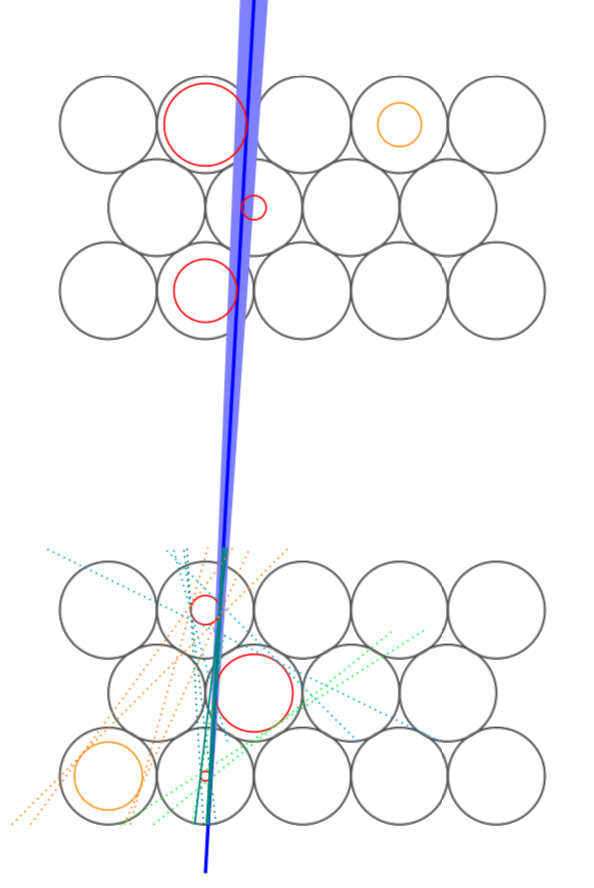Rare phenomena involving top quarks
The recent observation of processes involving four top quarks at the Large Hadron Collider provided by the ATLAS and CMS experiments is a spectacular result. Not only is the reconstruction of the busy final state challenging, also the process is expected to occur extremely rarely. Particularly exciting is that the observed cross-section is measured slightly higher than the prediction from the Standard Model.
Searches for top-philic resonances provide an interesting and timely opportunity to further explore multi-top-quark final state. I worked on a search which explores the TeV-scale mass range of top quark pairs produced in association with additional top quarks.
Publications
- EXOT-2022-14 – 24 April 2023, submitted to EPJC: Search for top-philic heavy resonances in pp collisions at √s=13 TeV with the ATLAS detector
Dark matter searches with ATLAS
I worked on a search for dark matter particles produced together with a hadronically decaying W/Z boson with the ATLAS detector. The hadronic decay of the vector boson is reconstructed as a dijet system (low boost) or as a single large-radius jet with requirements on jet substructure (high boost).
Recently I looked into the search for dark matter particles with a Higgs boson decaying into two b-quarks, a search which features two novel analysis techniques: VR track jets and missing transverse momentum significance.
For a summary paper of ATLAS searches for mediator-based dark matter and scalar dark energy models I served as co-liason for the mono-V analysis team. I derived constraints on vector- and axial-vector mediator based simplified dark matter models and a 2HDM + pseudoscalar model.
Peer-reviewed publications
- Phys. Rev. Lett. 126, 121802 – 26 March 2021: Search for Dark Matter Produced in Association with a Dark Higgs Boson Decaying into W±W∓ or ZZ in Fully Hadronic Final States from √s = 13 TeV pp Collisions Recorded with the ATLAS Detector
- Journal of High Energy Physics, Article number: 142 (2019) – 23 May 2019: Constraints on mediator-based dark matter and scalar dark energy models using √s = 13 TeV pp collision data collected by the ATLAS detector
- Journal of High Energy Physics, Article number: 180 (2018) – 29 October 2018: Search for dark matter in events with a hadronically decaying vector boson and missing transverse momentum in pp collisions at √s = 13 TeV with the ATLAS detector
Publications
- ATLAS-CONF-2018-039 – 25 July 2018: Search for Dark Matter Produced in Association with a Higgs Boson decaying to bb at √s=13 TeV with the ATLAS Detector using 79.8 fb-1 of proton-proton collision data
Analysis preservation and reinterpretation
Analysis preservation and reproducible workflows are crucial for open science. ATLAS offers RECAST, a tool to interpret existing analyses with new physics models. I am working on integrating analyses into RECAST and using it to constrain new physics models. One successful demonstration of RECAST is the reinterpretation of a search for dark matter produced in association with a Higgs boson decaying to b-quarks in terms of a dark Higgs model. From a technical perspective, this is also interesting, as it allows to work with continuous integration for regular tests of the code, docker containers for preservation and using cloud computing resources to run the analysis code for new models.
Publications
- ATL-PHYS-PUB-2022-045 – 4 November 2022: Active Learning reinterpretation of an ATLAS Dark Matter search constraining a model of a dark Higgs boson decaying to two b-quarks
- ATL-PHYS-PUB-2019-032 – 11 August 2019: RECAST framework reinterpretation of an ATLAS Dark Matter Search constraining a model of a dark Higgs boson decaying to two b-quarks
Flavour tagging
Flavour-tagging, the identification of jets originating from bottom and charm quarks, is a critically important technique in the data analysis of the ATLAS experiment. It is applied in precision measurements of the Standard Model and the Higgs boson, as well as in searches for yet unknown phenomena.
The long lifetime, high mass, and large decay multiplicity of hadrons containing bottom and charm quarks provide distinct signatures of charged particle trajectories in the detector which can be exploited by machine learning algorithms.
Publications
- FTAG-2019-07 – 24 November 2022, accepted by EPJC: ATLAS flavour-tagging algorithms for the LHC Run 2 pp collision dataset
ATLAS Muon Trigger Upgrade

I also took an interest in the MDT trigger development for the first-level muon trigger of the ATLAS experiment at the High-Luminosity LHC. As part of my master thesis at MPI/TUM I studied fast track reconstruction algorithms and did a trigger rate estimate comparing different trigger strategies.